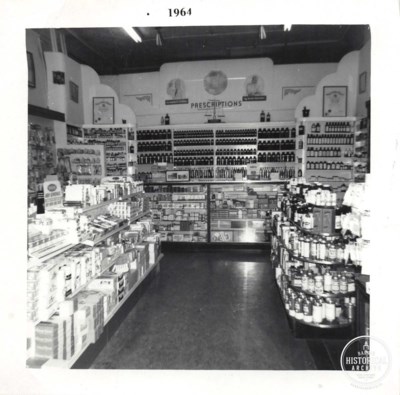Say what you like about big pharma and the piles of medications that doctors seem to like to prescribe today, but I will take my chances with modern medicine.
A century ago and more, folks in Barrie were like the rest of the so-called civilized world and relied on a combination of folk remedies, mysterious elixirs and tonics made and sold without much regulation, chemists doing the best they could and doctors who only guessed at the source of an ailment a lot of the time.
 Courtesy of the Barrie Historical Archive.
Courtesy of the Barrie Historical Archive. No antibiotics, no vaccines, no x-rays, no cancer treatments, no real relief for many of the terrible afflictions that we can hope to cure today.
My love of genealogy research has lead to reading many death registrations over the years, and in a lot of cases, I wonder how the doctor ever arrived at his diagnosis without the use of blood tests, urinalysis, surgery of some type or non-invasive procedure like ultrasound. The catch-all terms were applied – consumption, apoplexy, neoplasm, grippe, dropsy, ague.
What was a sick person to do? Your grandmother’s mustard plaster wasn’t working, and you could not bear the thought of drinking one more steaming cup of that healing tea the neighbour keeps offering, and there is no extra money for a doctor. Desperation makes willing customers of us all, and the snake oil liniment salesman was right there waiting to take our money.
 Courtesy of the Barrie Historical Archive.
Courtesy of the Barrie Historical Archive.Now, I’m not saying that all of these remedies were fraudulent. Some of them were made by local Barrie pharmacists, but the names and laundry list of purported curative properties make them just a little suspect in my eyes. I can well imagine though, that if you had several complaints, purchasing one bottle of magical cure-all oil, rather than two or three, would be appealing.
Cook’s Cotton Root Compound A recent discovery by an old physician, successfully used by thousands everywhere. It is the only perfectly safe and reliable medicine discovery. Beware of unprincipled druggists who order inferior medicines in place of this. Ask for Cooks Cotton Root Compound and take no substitute or enclose $1 and 4 three-penny Canada Postage stamps in letter and we will send by sealed return mail. Fully sealed particulars in plain envelope to ladies only, 2 stamps.
I’m not quite sure what Cook’s compound was supposed to cure, but apparently, ladies of the time knew all about it. The customer was invited, in this Barrie Examiner ad from June 9, 1892, to send to an address in Detroit, Michigan or buy it from a local dealer, which included D.H. McLaren, W.C. McLean, John Woods or G. Monkman.
At least D.H. McLaren was specific about his own compound’s capabilities when he advertised it in a small corner of the Barrie Examiner on July 12, 1900.
McLaren’s Wild Blackberry Compound Cures Diarrhoea, Dysentery and all Summer Complaints; Gives instant relief, pleasant to take, best bowel remedy known to children and adults. Price 25c a bottle. D.H. McLaren, Chemist, Druggist, Optician.
 Courtesy of the Barrie Historical Archive.
Courtesy of the Barrie Historical Archive. Hyomei Pronounced High-O-Me. Cures Catarrh, Asthma, Bronchitis, Croup, Cough, Colds or money back. Sold and guaranteed by H.G. Robertson.
Lots of Face Creams We have lots of them in stock and some of them are some good. But for a bright fresh complexion and feeling of comfort the best we can buy is Nyal’s Face Cream . . . The oxygen in it simply renews the life of the skin. It won’t grow hair; it is not greasy and the jar is a real ornament. Herbert G. Robertson Chemist 1 Door East of Barrie Hotel.
Good to know that if the face cream was no good, at least you had a pretty jar! Interesting too how the point of reference for many downtown Barrie businesses was the bar. No one seemed to feel the need to advertise a tavern by saying it was next door to the book store.
Found in nearly every drug store in Barrie, and everywhere else, was Beecham’s Pills. Invented in the 1840s before any kind of regulation, this typical cure-all claimed to “Dislodge Bile, Stir-up the Liver, Cure Sick-Headache, Female Ailments, Remove Disease and Promote Good Health.” In later years, Beecham’s could only truthfully claim that they had some effect on digestive issues since they were basically just a laxative. The main ingredients in their product were found to be aloe, ginger and soap.
I am fascinated too by the legitimate seeming news stories buried within the pages of the Barrie newspapers that were actually just lengthy advertisements. Today, they have to be clearly marked as such. Among others, I have seen various renditions of the Lydia E. Pinkham story.
On the 25 of October, 1906, the Barrie Examiner ran a story entitled Who Was She? Sketch of the Life of Lydia E. Pinkham and a True Story of How the Vegetable Compound Had its Birth and How the “Panic of ‘73” Caused it to be Offered for Sale in Public Drug Stores.
 Courtesy of the Barrie Historical Archive.
Courtesy of the Barrie Historical Archive. I would like to think that medicine has evolved greatly, and that consumers are more aware of what they are buying today. But in a world of $300 anti-aging creams, and TV ads for pills that have more side effects than curative properties, I’m not so sure.
Many thanks to the Barrie Examiner and Northern Advance, whose pages are archived at the Barrie Public Library.
Each week, the Barrie Historical Archive provides BarrieToday readers with a glimpse of the city’s past. This unique column features photos and stories from years gone by and is sure to appeal to the historian in each of us.



